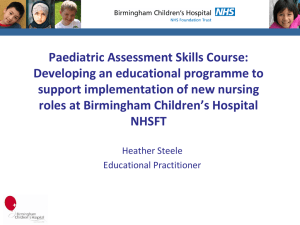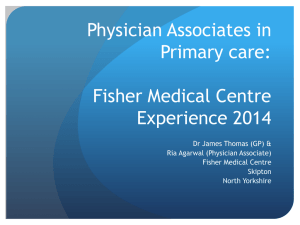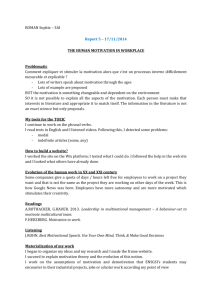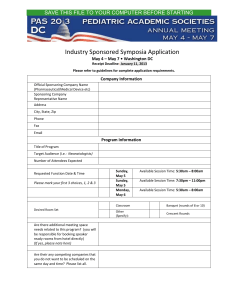OppOsing Assisted suicide in VermOnt
advertisement
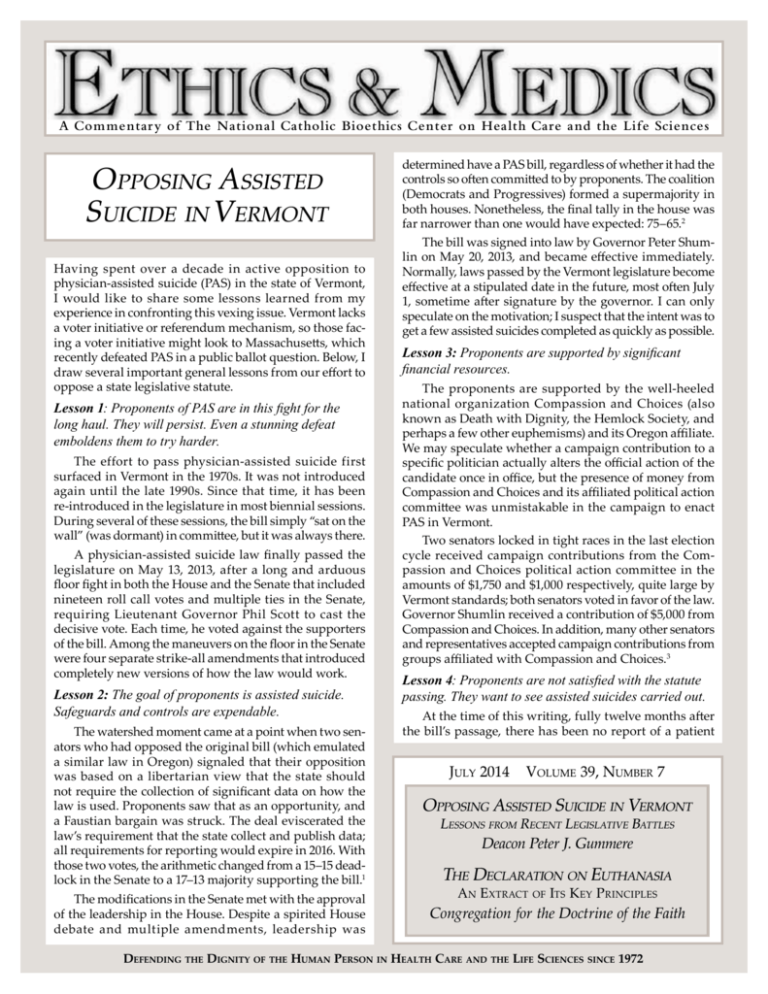
A Commentary of The National Catholic Bioethics Center on Health Care and the Life Sciences Opposing Assisted Suicide in Vermont Having spent over a decade in active opposition to physician-assisted suicide (PAS) in the state of Vermont, I would like to share some lessons learned from my ­experience in confronting this vexing issue. Vermont lacks a voter initiative or referendum mechanism, so those facing a voter initiative might look to Massachusetts, which ­recently defeated PAS in a public ballot question. Below, I draw several important general lessons from our effort to ­oppose a state legislative statute. Lesson 1: Proponents of PAS are in this fight for the long haul. They will persist. Even a stunning defeat emboldens them to try harder. The effort to pass physician-assisted suicide first surfaced in Vermont in the 1970s. It was not introduced again until the late 1990s. Since that time, it has been ­re-introduced in the legislature in most biennial sessions. During several of these sessions, the bill simply “sat on the wall” (was dormant) in committee, but it was always there. A physician-assisted suicide law finally passed the legislature on May 13, 2013, after a long and arduous floor fight in both the House and the Senate that included nineteen roll call votes and multiple ties in the Senate, requiring Lieutenant Governor Phil Scott to cast the ­decisive vote. Each time, he voted against the supporters of the bill. Among the maneuvers on the floor in the Senate were four separate strike-all amendments that introduced completely new versions of how the law would work. Lesson 2: The goal of proponents is assisted suicide. Safeguards and controls are expendable. The watershed moment came at a point when two senators who had opposed the original bill (which emulated a similar law in Oregon) signaled that their ­opposition was based on a libertarian view that the state should not require the collection of significant data on how the law is used. Proponents saw that as an opportunity, and a Faustian bargain was struck. The deal eviscerated the law’s requirement that the state collect and publish data; all requirements for reporting would expire in 2016. With those two votes, the arithmetic changed from a 15–15 deadlock in the Senate to a 17–13 majority supporting the bill.1 The modifications in the Senate met with the ­approval of the leadership in the House. Despite a spirited House debate and multiple amendments, leadership was ­ etermined have a PAS bill, regardless of whether it had the d controls so often committed to by proponents. The ­coalition (Democrats and Progressives) formed a supermajority in both houses. Nonetheless, the final tally in the house was far narrower than one would have expected: 75–65.2 The bill was signed into law by Governor Peter Shumlin on May 20, 2013, and became effective immediately. Normally, laws passed by the Vermont legislature become effective at a stipulated date in the future, most often July 1, sometime after signature by the governor. I can only speculate on the motivation; I suspect that the intent was to get a few assisted suicides completed as quickly as possible. Lesson 3: Proponents are supported by significant financial resources. The proponents are supported by the well-heeled national organization Compassion and Choices (also known as Death with Dignity, the Hemlock Society, and perhaps a few other euphemisms) and its Oregon affiliate. We may speculate whether a campaign contribution to a specific politician actually alters the official action of the candidate once in office, but the presence of money from Compassion and Choices and its affiliated political action committee was unmistakable in the campaign to enact PAS in Vermont. Two senators locked in tight races in the last election cycle received campaign contributions from the Compassion and Choices political action committee in the amounts of $1,750 and $1,000 respectively, quite large by Vermont standards; both senators voted in favor of the law. Governor Shumlin received a contribution of $5,000 from Compassion and Choices. In addition, many other senators and representatives accepted campaign contributions from groups affiliated with Compassion and Choices.3 Lesson 4: Proponents are not satisfied with the statute passing. They want to see assisted suicides carried out. At the time of this writing, fully twelve months after the bill’s passage, there has been no report of a patient July 2014 Volume 39, Number 7 Opposing Assisted Suicide in Vermont Lessons from Recent Legislative Battles Deacon Peter J. Gummere The Declaration on Euthanasia A n Extract of Its K ey P rinciples Congregation for the Doctrine of the Faith Defending the Dignity of the Human Person in Health Care and the Life Sciences since 1972 Ethics & Medics July 2014 Lesson 7: Form alliances with others opposed to PAS. successfully using the law. While two prescriptions have been written, both patients died of natural causes. One died before picking up the lethal medication. Among the many groups opposed to PAS are physicians, nurses, pharmacists, palliative care and hospice workers (nurses, social workers, and psychologists), advocates for the disabled, advocates for adolescents, a­ dvocates for the elderly, and others. The simple fact is that many people are put at risk by PAS legislation. Forming an ­alliance with these groups is essential. The challenges in doing so are not to be minimized, but achieving that synergy is critical to mounting an effective opposition. This means carefully working with disparate constituencies to ensure cooperation. Perhaps in response to the lack of participation by the public, Compassion and Choices has granted funds to the Vermont Ethics Network, which is now running presentations around the state explaining the law to the public. Among the ­presenters is Rep. Linda Waite-Simpson, an ardent proponent of the bill and now a part-time executive director of Compassion and Choices Vermont. This is an unabashed effort to stimulate the acceptance and use of PAS.4 Although the enactment of an assisted-suicide law was a moral victory for proponents, it was a shallow victory. Statewide, pharmacists feel unprotected and are not willing to fill a prescription written under the law. The law explicitly provides immunity from civil action or criminal prosecution to the physician writing the prescription. Yet the code of ethics for pharmacists provides that they must not fill a lethal prescription; doing so constitutes negligence. In the words of one pharmacist and friend who has no moral objections to assisted suicide, “I am not going to put my license or my financial resources at risk for the sake of this law. If they want me to participate, it would only be after clear immunity.” Lesson 8: Let the alliances be the face of the effort to defeat PAS. The Church must speak clearly about the moral ­issues associated with PAS. Bishop Salvatore Matano gave ­official testimony from the diocese in public opposition to PAS; however, anti-religious sentiment in general, and antiCatholic animus in particular, are overtly evident in the Vermont legislature. Therefore, major lobbying efforts must focus on issues other than morality; they must focus on why PAS is bad public policy. I testify as “Pete Gummere, a bioethicist from St. Johnsbury” rather than as “Pete Gummere, Catholic Deacon and bioethicist.” My testimony focuses on the risk of manipulation by a malevolent family member and on the suicide risk posed to teens, the elderly, and the disabled. Those messages got traction with legislators. I can cite (de-identified) cases I have seen involving overt efforts at manipulation of the terminally ill for monetary benefit. Health care institutions are also not protected; consequently, most hospitals have opted out of providing PAS “services.” Lesson 5: Clinical personnel oppose the law and do not want to be involved with it. While there are some health care professionals who are quite open about their own support for PAS, most do not support it. Most professional societies on record stand in opposition. Data from Oregon, the first state to legalize PAS, reveal that the overwhelming majority of Oregon physicians have never written a prescription under their PAS law. In the words of one Vermont pharmacist who o ­ pposes PAS, “I just don’t know why anyone would want to fill a prescription [for lethal medication]; it is just contrary to why I went into pharmacy.” Another gentleman attested to the conflict his ­ epressed teenager experienced from the mere public d discussion of assisted suicide; the teenager expressed outrage at the hypocrisy of adults: “Suicide is OK for adults but not for teens!” Although proponents boast that PAS does not increase suicide among vulnerable groups, there is evidence to the contrary.5 Sometimes this phenomenon is called “suicide contagion” and is common among vulnerable groups (teens, the elderly, and the disabled). The state of Oregon’s website demonstrates that although completed suicides among adolescents declined after the PAS law was passed, the number of suicide attempts actually rose significantly. This occurred even though a major effort to combat teen suicides had been initiated shortly before the PAS law was enacted.6 Lesson 6: The issue is not pain management. But that is how PAS is promoted to the public and to the legislature. Keep your eye on the real issue—personal choice. Those who support PAS can be very vocal; they use superficially reasonable and seductive logic focused on pain management. The polls used to demonstrate public support tend to focus on the question of whether we should allow people enduring physical pain to end their suffering. A more nuanced approach is to address existential angst. But the real bottom line is personal choice, and it is depicted as a civil rights issue. Anecdotally, six months after the PAS law was passed in Vermont, a psychologist told me that a suicidal client commented to her, “Now that suicide is legal, it’s OK! Right?” She related that incident to a colleague who ­responded by describing a very similar incident. The most effective counterargument is to demonstrate that creating that civil right infringes on the well-being and safety of others—particular vulnerable groups that might be influenced to commit suicide (teens, the elderly, or the disabled). Lesson 9: Opposition to PAS is bipartisan. Actively cultivate both sides of the aisle. This point was made vividly clear to me as the votes against PAS were tallied in the Vermont House in 2013. 2 Ethics & Medics July 2014 ­ pending its repeal.8 It remains to be seen how this will be With a solid, super-majority in the House, due to a coalition of the Democratic and Progressive parties, and with leadership of both of those parties in favor and Republican leadership opposing, the measure only passed the House by a slim margin: 71 votes were needed out of 140 votes cast; 75 votes were received. One House member from the Democratic party was a constant source of insight and information to PAS ­opponents. The same was true of another Democrat in the Senate. One of the more promising strike-all amendments introduced on the Senate floor likewise came from a Democratic senator; it would have neutralized the objectionable core of the law that was ultimately passed. dealt with in the next legislative biennium. Lesson 13: The power of prayer. Setting one’s feet into the rough and tumble world of lobbying a state legislature can be intimidating. But we have a special calling to fearlessly speak the truth, though always with love. In order to do that, we must be anchored in our relationship with God. We must always keep in mind that Jesus has already overcome the power of sin for us. We can be content that our job is only to help make it real in the place and time where we live. In 2007, as the PAS bill headed to a floor vote in the House, I prayed before the Blessed Sacrament the night before the debate. The vote counts indicated that the bill would pass by about 10 votes. I prayed for a miracle. Abruptly I had a powerful but fleeting sense of the Lord responding, “Relax and trust in me!” The following ­afternoon, I sat in the gallery of the House. A number of others were there specifically to pray for the defeat of the bill. As the debate proceeded, I still thought the bill would be passed that day. The representatives spoke from their hearts. Minds were being changed in the debate. One-byone they acknowledged their ambivalence and their fears. There was a net gain of about 20 “no” votes that afternoon; the bill died on the floor of the House.9 Lesson 10: Clergy and others in ongoing adult ­formation have an indispensable role to play in ­informing the Catholic people about the issue and about an ­appropriate moral stance. The Diocese of Burlington realized early on that education of our parishioners was critically important. In 2007, when the PAS bill went down to defeat in the House after a spirited floor debate, one angry representative bashed the Catholic Church for materially distorting the truth about the PAS law and for putting people up to calling representatives and asking them to vote against the law. This was a perfectly legal and appropriate strategy, but we wanted to avoid any suggestion in the next round that the Church was acting unfairly. As the 2011–2012 legislature approached, we decided to ensure that the best information would go out to the faithful. We targeted particular population clusters for education. We wanted them to be informed about the law whether it passed or not. Specific priests, deacons, and others were trained with the most accurate information and significant “talking points.” In the 2011–2012 biennium, the bill again appeared headed for passage. Again I prayed before the Blessed Sacrament; praying for another miracle. I prayed that proponents would have a miscue that could be turned into a major embarrassment. About a week later, one of the local newspapers ran an editorial about health care cost control. The author discussed his interview with a senior official in health care who said that passing the PAS law would help control costs. Lesson 11: Communications are critical and need to be professional. Damage done; the bill died that year. Final thoughts We were blessed with a great deal of pro bono help from a variety of professionals across a spectrum of disciplines, including communications professionals. Hence, we were able to conduct a communications campaign, including television advertising, for far less than might have been the case. We launched TV ads at strategic points of the struggle. We needed to plant seeds of doubt in the minds of the viewer; we wanted them to grow uncomfortable with the concept of a PAS law. Polling data indicated that we had achieved the desired impact on public opinion.7 The struggle continues. We hope to repeal Act 39 in the next legislative session. We know far more now than we did a year ago. We have a better sense of how to play the political game. Governor Shumlin, an arch supporter of PAS, is ­ olitically weaker than he was a year ago. Dissatisfaction p may work to our advantage on the PAS law. There are strong calls for ethics reform in state government and in the legislature itself. We are actively lobbying members of the legislature. Lesson 12: Accept even apparent defeats in the political realm as opportunities for adjustment in strategy and as temporary setbacks to be overcome. There is widespread awareness that Act 39 is a bad law, even “legislative malpractice.” 10 The bill has not achieved its intended outcome. The question is whether the legislature will have the intellectual honesty and the fortitude to repeal it. With Act 39 (the PAS law) nevertheless passing, many of us felt disheartened; however, the law has so many ambiguities in it that it now needs to go back to the legislature. One might mistake the final law as enacted for a product of the Tower of Babel rather than a thoughtful and deliberate action of an informed legislature. The Vermont Alliance for Ethical Healthcare has called for a moratorium Deacon Peter J. Gummere Deacon Peter J. Gummere is adjunct faculty at Pontifical College Josephinum in Columbus, Ohio. He is also a bioethics speaker and consultant for the Diocese of Burlington, Vermont and a 3 The National Catholic Bioethics Center 6399 Drexel Road, Philadelphia, PA 19151–2511 www.ncbcenter.org Volume 39, Number 7 July 2014 Views expressed are those of individual authors and may ­advance positions that have not yet been doctrinally settled. Ethics & Medics makes every effort to publish articles consonant with the magisterial teachings of the Catholic Church. member of the Advisory Committee of the Vermont Alliance for Ethical Healthcare. The Declaration on Euthanasia To view the legislative history of the bill, see the Vermont Legislative Bill Tracking System, 2013–2014 Legislative Session, S.77 (Act 0039), An Act Relating to Patient Choice and Control at End of Life, at http://www.leg.state.vt.us/database/status/summary .cfm?Bill=S%2E0077&Session=2014. 2 Ibid. 3 Terri Hallenbeck, “Vermont End-of-Life Bill: Outcome Not Easy to Predict,” BurlingtonFreePress.com, February 3, 2013, http://www .burlingtonfreepress.com/article/20130204/NEWS02/302040022. 4 “Making It a Reality: Death with Dignity in Vermont,” Compassion andChoices.org, January 8, 2014, https://www.compassionand choices.org/2014/01/08/making-it-a-reality-death-with-dignity -in-vermont/. 5 Andreas Frei et al., “The Werther Effect and Assisted Suicide,” Suicide and Life Threatening Behavior 33.2 (June 2003), http://guil fordjournals.com/doi/abs/10.1521/suli.33.2.192.22768. 6 Oregon Health Authority, “A Call to Prevent Youth Suicide in ­Oregon,” Oregon.gov, https://public.health.oregon.gov/Prevention Wellness/SafeLiving/SuicidePrevention/2000plan/Pages/plan .aspx. 7 Vermont Alliance for Ethical Healthcare, “New Poll Finds ­Vermonters Opposed to Doctor-Assisted Suicide,” press release, April 15, 2013, http://www.vaeh.org/resources/Vermont%20 PAS%20Poll%20March%202013.htm. 8 Morgan True, “Opponents Call for Repeal of Assisted Suicide,” VTDigger.org, February 27, 2014, http://vtdigger.org/2014/02/27/ opponents-call-repeal-assisted-suicide/. 9 To view the legislative history of the bill, see the Vermont Legislative Bill Tracking System, 2007–2008 Legislative ­S ession, H.0044, Patient Choice and Control at End of Life, at http://www.leg.state.vt.us/database/status/summary .cfm?Bill=H%2E0044&Session=2008. 10 Edward J. Mahoney, “My Turn: Legislative Malpractice,” Suicide LawSuits.org, August 16, 2013, http://suicidelawsuits.org/my -turn-legislative-malpractice/. 1 1. No one can make an attempt on the life of an innocent person without opposing God’s love for that person, without violating a fundamental right, and therefore without committing a crime of the utmost gravity. 2. Everyone has the duty to lead his or her life in a­ ccordance with God’s plan. That life is entrusted to the individual as a good that must bear fruit already here on earth, but that finds its full perfection only in eternal life. 3. Intentionally causing one’s own death, or suicide, is therefore equally as wrong as murder; such an action on the part of a person is to be considered as a rejection of God’s sovereignty and loving plan. Furthermore, suicide is also often a refusal of love for self, the denial of a natural instinct to live, a flight from the duties of justice and charity owed to one’s neighbor, to various communities or to the whole of society—although, as is generally recognized, at times there are psychological factors present that can diminish responsibility or even completely remove it. However, one must clearly distinguish suicide from that sacrifice of one’s life whereby for a higher cause, such as God’s glory, the salvation of souls or the service of one’s brethren, a person offers his or her own life or puts it in danger (cf. Jn. 15:14). Congregation for the Doctrine of the Faith Rome May 5, 1980 4 Ethics & Medics is a publication of The National Catholic Bioethics Center. Regular annual subscription rate for 12 issues includes both the print version by mail and online access at www.ncbcenter.org/em: U.S. A. $28; foreign $38; institutional $55. Individual copies are available at $3.00 each. To subscribe, please write to The National Catholic Bioethics Center, 6399 Drexel Rd., Philadelphia, PA 19151–2511, e-mail orders@ncbcenter.org, or phone (215) 877–2660. Publisher: John M. Haas, STL, PhD; Editor: Edward J. Furton, MA, PhD. Contents © 2014 The National Catholic Bioethics Center. ISSN 1071–3778 (print), ISSN 1938–1638 (online). For permission to reuse material from Ethics & Medics, please access www.copyright.com or contact the Copyright Clearance Center, Inc. (CCC), 222 Rosewood Drive, ­Danvers, MA 01923, phone (978) 750–8400.

